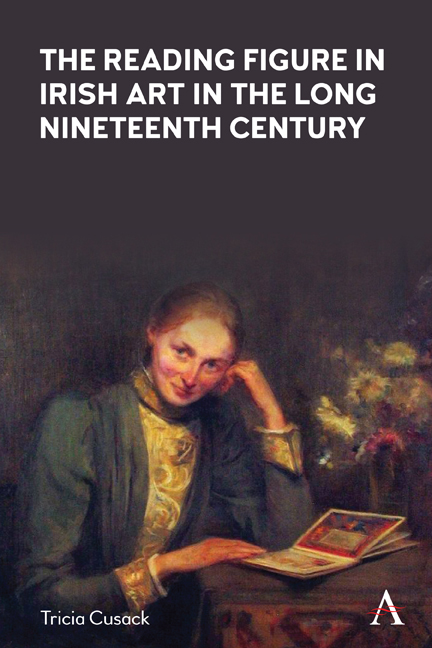Book contents
- Frontmatter
- Contents
- List of Figures
- Acknowledgements
- Introduction
- 1 Imperial Man, Manly Nationalism and the Unmanly Reader
- 2 ‘Creatures of a Different Breed’: Women Readers and Patriarchal Discourse
- 3 The Shaping of the New Woman in Ireland
- 4 The Silent Reader and the Fictive Viewer
- 5 A Room of Her Own: Four New Women in Dublin
- Conclusion
- Notes
- Works Referenced
- Index
4 - The Silent Reader and the Fictive Viewer
Published online by Cambridge University Press: 27 April 2022
- Frontmatter
- Contents
- List of Figures
- Acknowledgements
- Introduction
- 1 Imperial Man, Manly Nationalism and the Unmanly Reader
- 2 ‘Creatures of a Different Breed’: Women Readers and Patriarchal Discourse
- 3 The Shaping of the New Woman in Ireland
- 4 The Silent Reader and the Fictive Viewer
- 5 A Room of Her Own: Four New Women in Dublin
- Conclusion
- Notes
- Works Referenced
- Index
Summary
A number of Irish portraits executed during the long nineteenth century depict a single reader, usually a woman, silently absorbed in a book, such as Sarah Purser's The Afternoon Read (oil on canvas board, n.d., Figure 15), or sometimes momentarily interrupted from it, as in Estella Solomons's Portrait of a Woman (oil on canvas, n.d., Figure 16). These portraits, largely by women artists, were produced in the context of the movements towards greater independence and better educational opportunities for women. Embodying new habits of reading, they show women occupied in independent intellectual and imaginative activity. Chapter 4 argues that such depictions of solitary engagement in a text by a female figure and the implied practice of silent reading helped to constitute a typology of the New Woman as literate, focused and reflective.
The chapter has five sections, each of which analyses a particular aspect of these portraits, with reference to examples. The first section, ‘Silent Reading and Space for Interiority’, explores the concept of silent reading. It explains how silent reading was related to the development and proliferation of the novel, when reading also became subject to literary judgements and issues of taste. Reading therefore became a complex activity, and one in which women readers would become intimately engaged. The second section, ‘Absorption and the Reading Figure’, examines the concept of ‘absorption’ in art, showing its particular application to the reading figure. The notion of the absorbed reader is intimately connected to the idea of the imagined viewer of an artwork, and the concept of the ‘fictive viewer’ is explored. The ‘absorbed’ reading figure had a counterpoise in the ‘interrupted’ reader, and this embodiment is discussed in section three, ‘The Interrupted Reader’.
‘The Style of the Reader’, section four, considers the overall style(s) of the portraits and their use of traditional or modernist techniques, especially the use of colour. It also explores the potential symbolism of the reader's bodily attitude. Section five, ‘A Private Space’, concerns the reader's habitat. This section examines the domestic settings depicted in some of these portraits which invoke a private space within which a woman could undertake her own study and creative work.
- Type
- Chapter
- Information
- Publisher: Anthem PressPrint publication year: 2022



